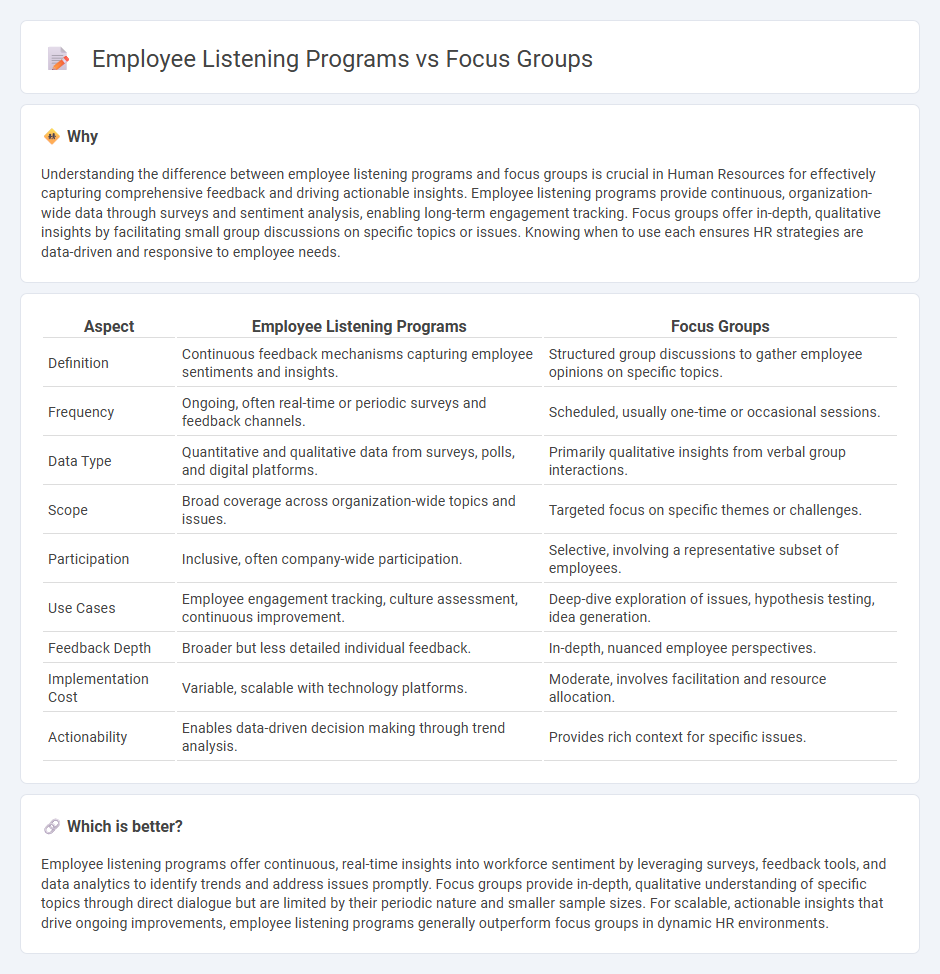
Employee listening programs provide continuous feedback mechanisms through surveys, chatbots, and pulse polls, enabling organizations to monitor engagement and workplace sentiment in real-time. Focus groups offer in-depth qualitative insights by facilitating direct discussions among select employee samples, uncovering nuanced attitudes and concerns. Discover how these methods can transform your HR strategy and enhance organizational culture.
Why it is important
Understanding the difference between employee listening programs and focus groups is crucial in Human Resources for effectively capturing comprehensive feedback and driving actionable insights. Employee listening programs provide continuous, organization-wide data through surveys and sentiment analysis, enabling long-term engagement tracking. Focus groups offer in-depth, qualitative insights by facilitating small group discussions on specific topics or issues. Knowing when to use each ensures HR strategies are data-driven and responsive to employee needs.
Comparison Table
| Aspect | Employee Listening Programs | Focus Groups |
|---|---|---|
| Definition | Continuous feedback mechanisms capturing employee sentiments and insights. | Structured group discussions to gather employee opinions on specific topics. |
| Frequency | Ongoing, often real-time or periodic surveys and feedback channels. | Scheduled, usually one-time or occasional sessions. |
| Data Type | Quantitative and qualitative data from surveys, polls, and digital platforms. | Primarily qualitative insights from verbal group interactions. |
| Scope | Broad coverage across organization-wide topics and issues. | Targeted focus on specific themes or challenges. |
| Participation | Inclusive, often company-wide participation. | Selective, involving a representative subset of employees. |
| Use Cases | Employee engagement tracking, culture assessment, continuous improvement. | Deep-dive exploration of issues, hypothesis testing, idea generation. |
| Feedback Depth | Broader but less detailed individual feedback. | In-depth, nuanced employee perspectives. |
| Implementation Cost | Variable, scalable with technology platforms. | Moderate, involves facilitation and resource allocation. |
| Actionability | Enables data-driven decision making through trend analysis. | Provides rich context for specific issues. |
Which is better?
Employee listening programs offer continuous, real-time insights into workforce sentiment by leveraging surveys, feedback tools, and data analytics to identify trends and address issues promptly. Focus groups provide in-depth, qualitative understanding of specific topics through direct dialogue but are limited by their periodic nature and smaller sample sizes. For scalable, actionable insights that drive ongoing improvements, employee listening programs generally outperform focus groups in dynamic HR environments.
Connection
Employee listening programs and focus groups are integral tools in Human Resources for gathering authentic feedback and insights directly from employees. These initiatives facilitate two-way communication, enabling HR teams to identify workplace challenges and improve employee engagement. Focus groups serve as a structured format within employee listening programs, allowing targeted discussions that generate actionable data for organizational development.
Key Terms
Qualitative Feedback (Focus Groups)
Focus groups provide in-depth qualitative feedback by facilitating dynamic discussions that uncover employee attitudes, emotions, and motivations, offering rich insights beyond quantitative metrics. These sessions enable organizations to explore complex issues and gather nuanced perspectives directly from diverse employee groups. Discover how leveraging focus groups can enhance your employee listening strategy for more impactful engagement.
Continuous Listening (Employee Listening Programs)
Continuous listening through employee listening programs enables organizations to gather real-time feedback, enhancing agility and responsiveness to workplace issues. Unlike traditional focus groups that provide periodic insights, continuous listening fosters a culture of ongoing dialogue and employee engagement by capturing sentiments through surveys, pulse polls, and digital platforms. Discover how continuous listening can transform employee experience and drive organizational success.
Actionable Insights
Focus groups provide targeted qualitative data by engaging selected employees in structured discussions, capturing nuanced feedback and emotional responses. Employee listening programs leverage continuous, organization-wide feedback channels such as surveys, pulse checks, and digital platforms to gather real-time insights. Explore how combining both methods can maximize actionable insights and enhance employee experience.
Source and External Links
What Is a Focus Group? - A focus group is a market research method involving 6-10 participants discussing a product or service under the guidance of a trained moderator.
Focus Groups - Focus groups are moderated discussions involving individuals with a common characteristic, used to gather insights into their experiences and perspectives.
Focus Group - Focus groups are organized to obtain participant opinions and feedback on a topic or question, often used in market research and policy development.
 dowidth.com
dowidth.com